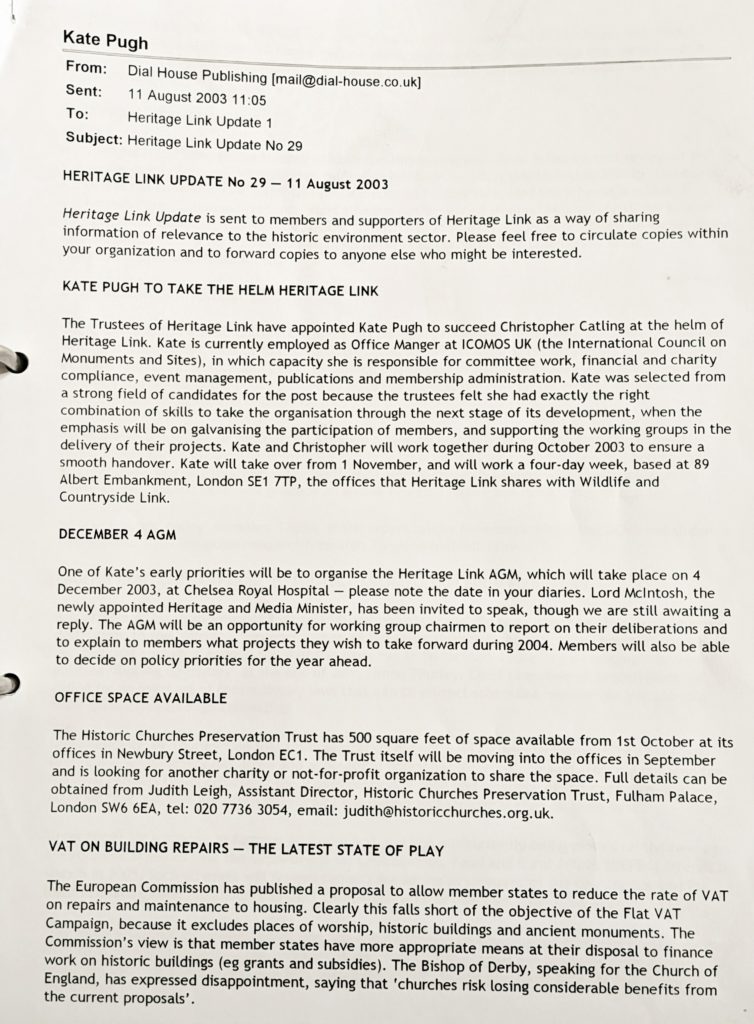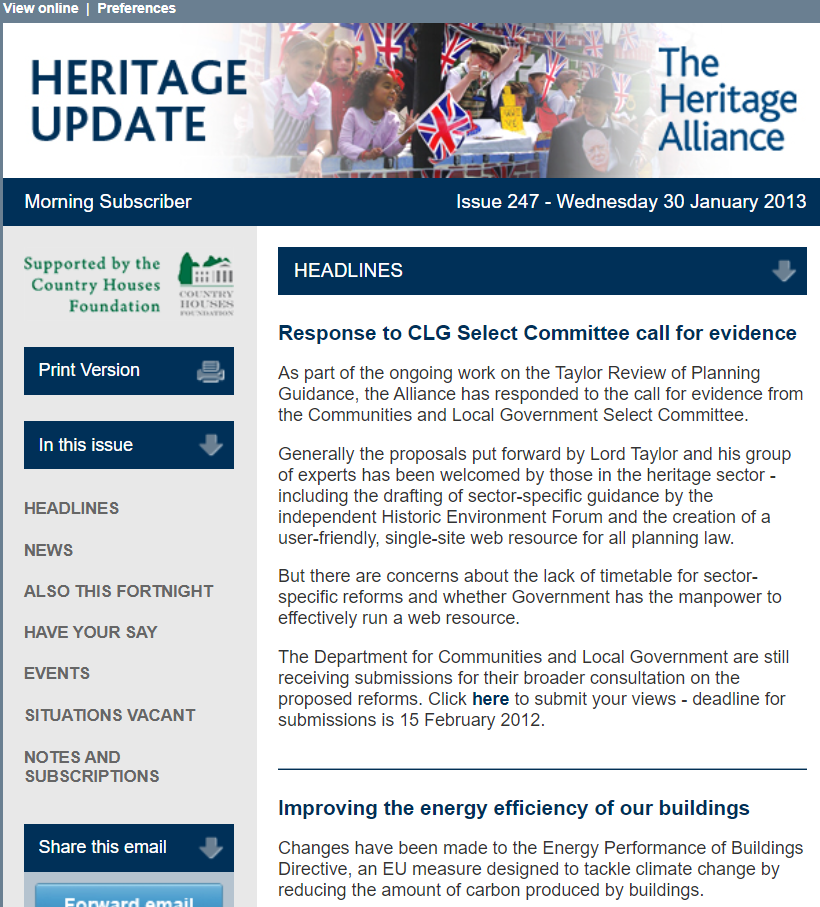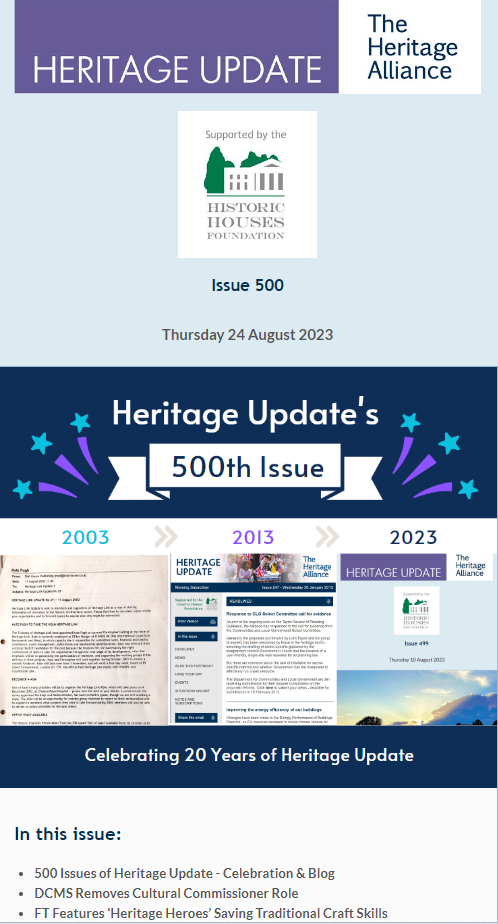Max Clark, Communications Manager
When I first started in my position as Communications Manager here at the Heritage Alliance, I knew I’d be taking over the task of writing and editing Heritage Update but I wasn’t aware of this newsletter’s long history. The 500th Issue of Heritage Update has been published today, representing the culmination of over 20 years of e-newsletters. We here at the Heritage Alliance thought it would be an excellent time to reflect on the past two decades of Heritage Update (HU) and its evolution.
HU has been in production since 2003, before we were known as the Heritage Alliance. In those days we were called Heritage Link – the name changed in 2011 as part of a decision to give the organisation a wider and more active role. The purpose at the beginning was simple: ‘sharing information of relevance to the historic environment sector‘, at that time in a plain email format.
The benefits were immediate. While there would be other newsletters that covered museums or cultural issues in part, such as Ed Vaizey’s The Vaizey View, Heritage Update was unique in that it covered the breadth and depth of the heritage sector alone, and provided both news and analysis of unravelling events. Published every two weeks, it was also the most regular source of sector information.

The very first edition of Heritage Update has been lost to the annals of time (and email archives), but we have uncovered issue 29, published 20 years ago this month in August 2003. This was the very first year of Heritage Link – when Tony Blair was Prime Minister, the Concorde was about to make its final flight, Radiohead headlined Glastonbury Festival, and the UK was experiencing its hottest summer on record.
In this issue, Kate Pugh was announced as the new Chief Executive of Heritage Link, a position she went on to hold for 13 years until 2016. We also advertised our very first AGM featuring a speech from Lord McIntosh, then Media and Heritage Minister. He served under Culture Secretary Tessa Jowell – the longest serving Secretary of State DCMS has had before or since.
Then as now, VAT was high on the agenda. We featured a story about the European Commission proposing that member states reduce VAT on repairs and maintenance – but curiously, their proposition excluded places of worship, ancient monuments and listed buildings. On home soil, English Heritage had just launched their ‘Ripping Up History’ campaign, calling for an overhaul of agricultural practices that permitted damage to the historic environment.
Another familiar story appears on the Elgin Marbles, with British Museum trustees denying that the sculptures will be returned to Athens for the 2004 Olympics and stating they ‘cannot envisage any circumstance under which they would accede to the Greek Government’s request’. Later in this issue, however, we reported on the repatriation of four aboriginal skulls from the Manchester Museum alongside other relics from the Horniman Museum and Royal College of Surgeons as ‘an act that recognises our common humanity’. 20 years later, these issues are still fresh.

Since then the core purpose has remained the same, though HU has changed. 10 years in, we implemented a move to a sectioned format which meant readers could identify news by topic and find sector specific news, events and vacancies. We also adopted a new design style, featuring our signature colours of white and blue. Images were beginning to be included, though only in the headers.
Our readership grew quickly into the thousands, thanks in no small part to our members who shared it broadly with their own sector colleagues and member audiences. Critically, its reach has grown to encompass all forms of stakeholders from across the sector – hundreds of government officials, policymakers, students, professors, archaeologists, planners, curators and professionals of all types. It has also proved to be the source of a valuable benefit for our members, who are able to advertise their events, vacancies, and news for free as often as they like.

In 2021 we updated our format further when we moved to our current platform Campaign Monitor, creating the sleek style of the newsletter you see today. We’ve also made Update more visual and have formalised the content list to consistently feature updates from us, the government, and our members alongside spotlights on events, jobs and training opportunities.
Now after 20 years, we’re looking ahead to the future of Heritage Update. We recently commenced a survey exploring your perspectives on Heritage Update and received overwhelmingly positive feedback from readers, for which we’re incredibly grateful. We also received useful suggestions on what steps we could take to make it better, and are now analysing your perspectives on our navigation, length, use of images, and much more.
We want to thank all of our readers for engaging with, contributing to, sharing, and supporting Heritage Update for the past 20 years. We’re grateful in particular to our sponsor, the Historic Houses foundation, whose grants have sustained HU and enabled its expansion. We’re glad to be able to provide a useful resource to the sector and are excited to see what the next 20 years hold.
Here’s what our readers had to say about Heritage Update in our latest survey:
“I will tell anyone who will listen – it’s an incredibly useful email.”
“It is really useful to have so many elements of sector news gathered into one bulletin – which manages to remain quite concise!”
“A one-stop-shop to know what I need to know”
“I always look forward to Heritage Update landing in my inbox and know how valuable and interesting my team members find it too. Thank you for this great resource. We would really miss it if it weren’t there!”
“It’s incredibly comprehensive and I treat it a bit like a professional briefing – I get all the updates I need from the sector from it essentially. Really impressive.”
“The Heritage Update is my absolute go-to as a strategic lead in my organisation.”
“Thank you for your time in putting this together. I have used and shared the information contained in the email on numerous occasions I think more heritage and conservation teams in local authorities should know about this!”
With thanks to the Historic Houses Foundation for their continued sponsorship of Heritage Update, without whom this work would not be possible, and to the previous writers and editors of Heritage Update: Daniella Briscoe-Peaple, Polly Martin, Hannah Shimko, Joe McDonnell, Emma Robinson, and Matthew Rabagliati.
